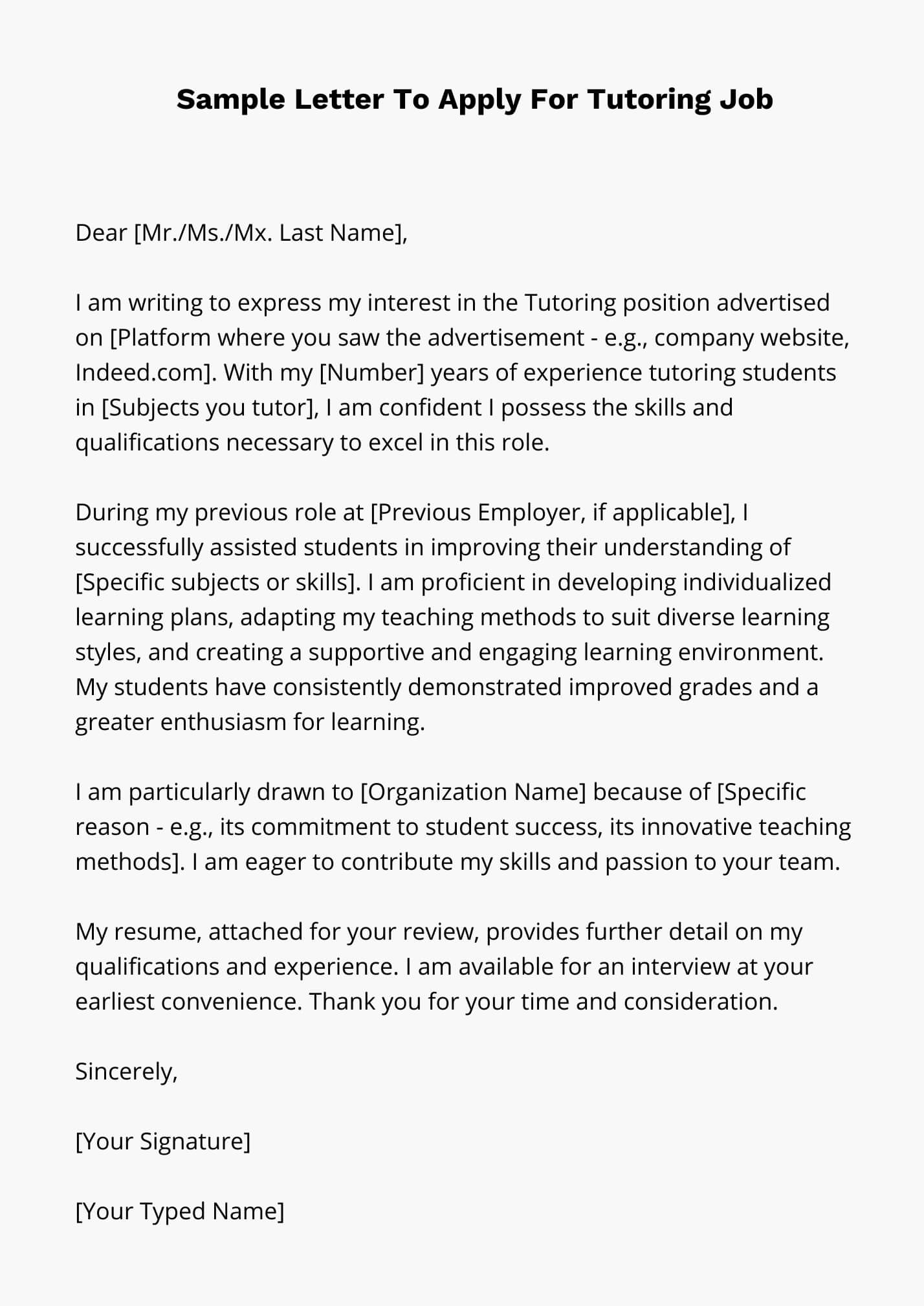Need a tutoring job? A “Sample Letter To Apply For Tutoring Job” is your first step. It’s how you introduce yourself to potential employers. You need it when applying for tutoring positions.
Writing feels hard? Don’t worry. We’ve got you covered.
This article shares letter samples. Use these samples to make writing easy. Get ready to impress!
Sample Letter To Apply For Tutoring Job
[Your Name]
[Your Address]
[Your Phone Number]
[Your Email Address]
[Date]
[Hiring Manager Name] (If known, otherwise use title)
[Hiring Manager Title]
[Organization Name]
[Organization Address]
Dear [Mr./Ms./Mx. Last Name],
I am writing to express my interest in the Tutoring position advertised on [Platform where you saw the advertisement – e.g., company website, Indeed.com]. With my [Number] years of experience tutoring students in [Subjects you tutor], I am confident I possess the skills and qualifications necessary to excel in this role.
During my previous role at [Previous Employer, if applicable], I successfully assisted students in improving their understanding of [Specific subjects or skills]. I am proficient in developing individualized learning plans, adapting my teaching methods to suit diverse learning styles, and creating a supportive and engaging learning environment. My students have consistently demonstrated improved grades and a greater enthusiasm for learning.
I am particularly drawn to [Organization Name] because of [Specific reason – e.g., its commitment to student success, its innovative teaching methods]. I am eager to contribute my skills and passion to your team.
My resume, attached for your review, provides further detail on my qualifications and experience. I am available for an interview at your earliest convenience. Thank you for your time and consideration.
Sincerely,
[Your Signature]
[Your Typed Name]

How to Write Letter To Apply For Tutoring Job
Subject Line: Capturing Attention from the Get-Go
- Keep it concise and pragmatic. Think “Tutoring Application – [Your Name] – [Subject]”.
- Avoid ambiguity. The recipient should immediately understand the letter’s purpose.
- If responding to a specific job posting, reference the job ID or title explicitly.
Salutation: Setting a Respectful Tone
- If you know the recipient’s name, use it: “Dear Mr./Ms./Dr. [Last Name],”.
- Avoid generic greetings like “To Whom It May Concern” unless absolutely necessary. Opt for “Dear Hiring Manager,” if the name is elusive.
- Maintain formality. This isn’t a casual missive to a friend; it’s a professional overture.
Introduction: Hooking the Reader Instantly
- State your purpose unequivocally. For example, “I am writing to express my keen interest in the Tutoring position advertised on [Platform]”.
- Briefly introduce yourself and your relevant qualifications. Highlight the aspects that align most closely with the job description.
- Evoke enthusiasm. Let your passion for tutoring and the subject matter shine through.
Body Paragraphs: Showcasing Your Pedagogy
- Elaborate on your experience. Quantify your achievements whenever possible. “Improved student grades by 15% on average”.
- Detail your tutoring philosophy. How do you approach teaching? What makes your methods efficacious?
- Address specific requirements mentioned in the job posting. Demonstrate that you’ve meticulously reviewed their needs.
- Use concrete examples to illustrate your prowess. Stories resonate more than mere declarations.
Skills and Qualifications: Underscoring Your Aptitude
- List your relevant skills: subject matter expertise, patience, communication skills, adaptability.
- Mention any certifications, degrees, or specialized training that augment your candidacy.
- Emphasize your ability to explain complex concepts in an accessible manner. This is paramount for effective tutoring.
Call to Action: Proactively Soliciting an Interview
- Express your eagerness to discuss your qualifications further.
- Clearly state your availability for an interview.
- Reiterate your contact information for easy access.
Closing: Leaving a Lasting Impression
- Use a professional closing: “Sincerely,” or “Respectfully,”.
- Follow with your full name.
- Consider adding your phone number and email address below your name for added convenience.
Frequently Asked Questions About Tutoring Job Application Letters
Applying for a tutoring position often requires a well-crafted application letter. Here are some frequently asked questions to guide you through the process and help you create a compelling application.
What should be included in the opening paragraph of my tutoring application letter?
The opening paragraph should clearly state the position you are applying for and how you learned about the opportunity. You should also briefly introduce yourself and highlight your key qualifications.
How can I effectively showcase my tutoring experience in the letter?
Provide specific examples of your tutoring experience, quantifying your achievements whenever possible. Focus on the positive impact you had on students’ academic performance and overall learning experience.
Should I include my educational qualifications and relevant skills?
Yes, clearly state your educational background, including degrees earned and relevant coursework. Highlight skills such as communication, patience, subject matter expertise, and the ability to adapt to different learning styles.
How important is it to tailor the letter to the specific tutoring job description?
Tailoring your letter to the specific requirements mentioned in the job description is crucial. Emphasize the skills and experiences that directly align with the employer’s needs and demonstrate your understanding of the role.
What should I include in the closing paragraph of my tutoring application letter?
Express your enthusiasm for the opportunity and reiterate your key qualifications. Thank the reader for their time and consideration, and clearly state your availability for an interview. Provide your contact information for easy follow-up.